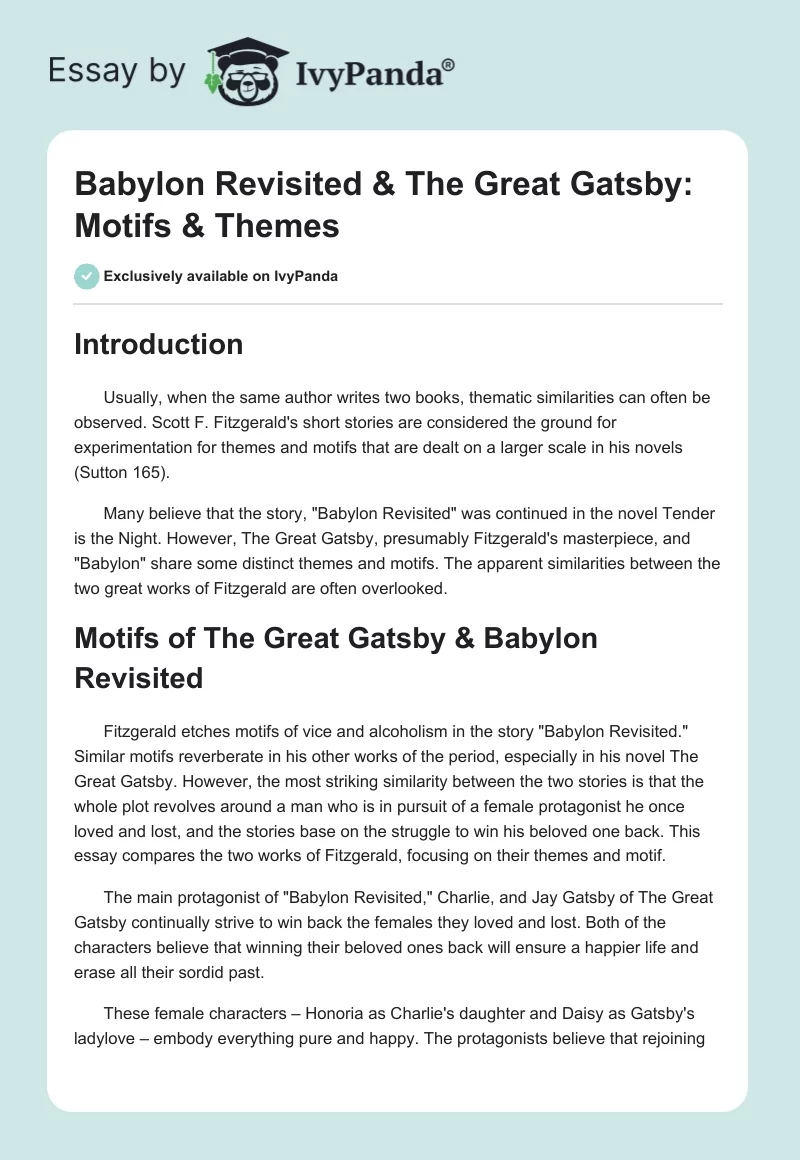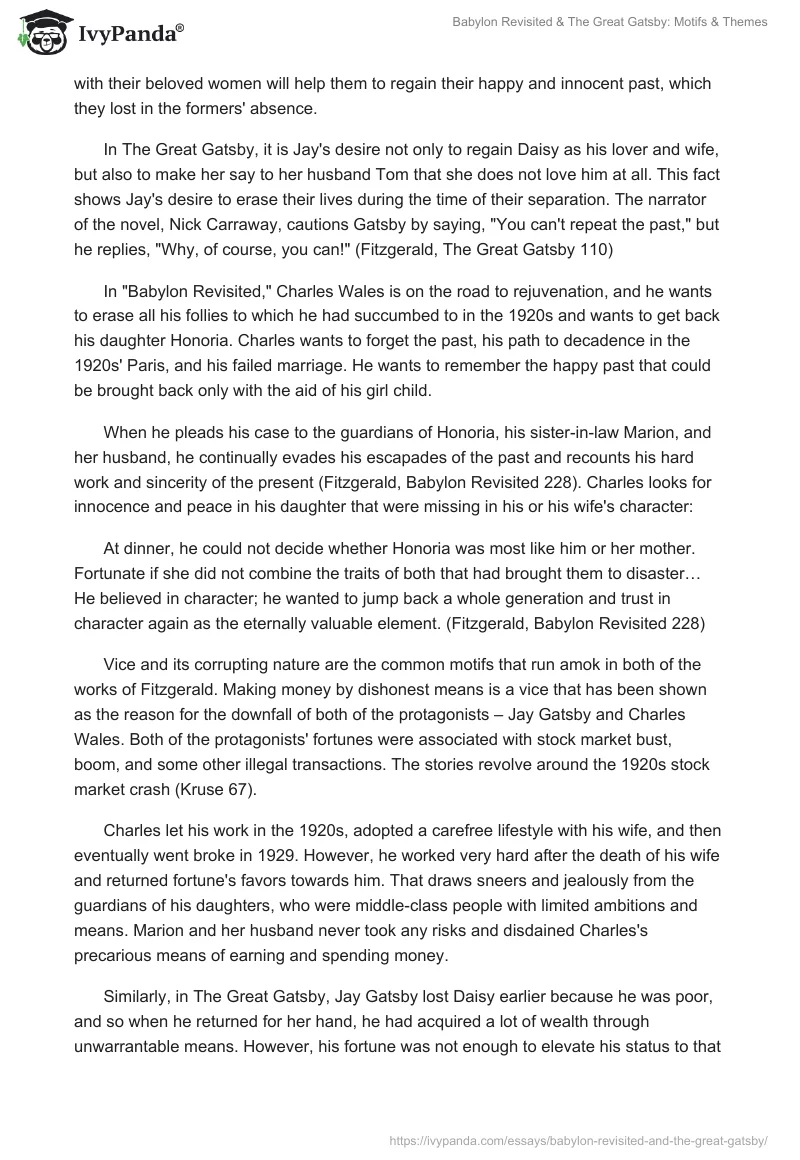Introduction
Usually, when the same author writes two books, thematic similarities can often be observed. Scott F. Fitzgerald’s short stories are considered the ground for experimentation for themes and motifs that are dealt on a larger scale in his novels (Sutton 165).
Many believe that the story, “Babylon Revisited” was continued in the novel Tender is the Night. However, The Great Gatsby, presumably Fitzgerald’s masterpiece, and “Babylon” share some distinct themes and motifs. The apparent similarities between the two great works of Fitzgerald are often overlooked.
Motifs of The Great Gatsby & Babylon Revisited
Fitzgerald etches motifs of vice and alcoholism in the story “Babylon Revisited.” Similar motifs reverberate in his other works of the period, especially in his novel The Great Gatsby. However, the most striking similarity between the two stories is that the whole plot revolves around a man who is in pursuit of a female protagonist he once loved and lost, and the stories base on the struggle to win his beloved one back. This essay compares the two works of Fitzgerald, focusing on their themes and motif.
The main protagonist of “Babylon Revisited,” Charlie, and Jay Gatsby of The Great Gatsby continually strive to win back the females they loved and lost. Both of the characters believe that winning their beloved ones back will ensure a happier life and erase all their sordid past.
These female characters – Honoria as Charlie’s daughter and Daisy as Gatsby’s ladylove – embody everything pure and happy. The protagonists believe that rejoining with their beloved women will help them to regain their happy and innocent past, which they lost in the formers’ absence.
In The Great Gatsby, it is Jay’s desire not only to regain Daisy as his lover and wife, but also to make her say to her husband Tom that she does not love him at all. This fact shows Jay’s desire to erase their lives during the time of their separation. The narrator of the novel, Nick Carraway, cautions Gatsby by saying, “You can’t repeat the past,” but he replies, “Why, of course, you can!” (Fitzgerald, The Great Gatsby 110)
In “Babylon Revisited,” Charles Wales is on the road to rejuvenation, and he wants to erase all his follies to which he had succumbed to in the 1920s and wants to get back his daughter Honoria. Charles wants to forget the past, his path to decadence in the 1920s’ Paris, and his failed marriage. He wants to remember the happy past that could be brought back only with the aid of his girl child.
When he pleads his case to the guardians of Honoria, his sister-in-law Marion, and her husband, he continually evades his escapades of the past and recounts his hard work and sincerity of the present (Fitzgerald, Babylon Revisited 228). Charles looks for innocence and peace in his daughter that were missing in his or his wife’s character:
At dinner, he could not decide whether Honoria was most like him or her mother. Fortunate if she did not combine the traits of both that had brought them to disaster… He believed in character; he wanted to jump back a whole generation and trust in character again as the eternally valuable element. (Fitzgerald, Babylon Revisited 228)
Vice and its corrupting nature are the common motifs that run amok in both of the works of Fitzgerald. Making money by dishonest means is a vice that has been shown as the reason for the downfall of both of the protagonists – Jay Gatsby and Charles Wales. Both of the protagonists’ fortunes were associated with stock market bust, boom, and some other illegal transactions. The stories revolve around the 1920s stock market crash (Kruse 67).
Charles let his work in the 1920s, adopted a carefree lifestyle with his wife, and then eventually went broke in 1929. However, he worked very hard after the death of his wife and returned fortune’s favors towards him. That draws sneers and jealously from the guardians of his daughters, who were middle-class people with limited ambitions and means. Marion and her husband never took any risks and disdained Charles’s precarious means of earning and spending money.
Similarly, in The Great Gatsby, Jay Gatsby lost Daisy earlier because he was poor, and so when he returned for her hand, he had acquired a lot of wealth through unwarrantable means. However, his fortune was not enough to elevate his status to that of the class that was rich by birth, as pointed out by Tom, Daisy’s husband, who call Jay a “Mr. Nobody from Nowhere” (Fitzgerald, The Great Gatsby 123).
Tom sneers at him for his nouveau riche taste, especially for his mansion and soirees, and Daisy blames him for his extravagance. The pennilessness and Jay’s lack of class haunts him increasingly when he tries to regain the love and trust of his beloved woman. In both stories, the protagonists’ past becomes a hindrance to achieving their goals in the present. The impoverished past of Gatsby and Charles’s perilous history haunt them both in the present and become their most significant difficulties.
The end of both stories reverberates the failure of the protagonists. Jay Gatsby failed to win back his ladylove, while Charles Wales was unable to get custody of his daughter. Both their dreams are destroyed when the signs of their corrupted life affront their present, creating a climax (Kerr 415). Gatsby initially gains Daisy’s love when he sweeps her with his charm, love, and emotional sentiments along with the demonstration of his newly acquired riches.
However, Tom, jealous and determined to expose Gatsby’s dubious dealings, bares him in front of Daisy to reveal a man who has made money solely through illegal means. Gatsby tried to insist on Daisy, saying that she never loved Tom to erase Tom from his and Daisy’s past. That is why he says, “Your wife never loved you. … She never loved you. She loves me” (Fitzgerald, The Great Gatsby, 124). After this incident, Tom exposes Gatsby as a swindler to smear his image in front of Daisy.
In “Babylon Revisited,” when Charlie is trying to persuade his sister and brother-in-law of his changed nature and wants to take over his daughter’s guardianship, his past in the form of his drunk and uninvited friends Lorraine and Duncan enters Marion’s house, and they create ruckus to take Charlie with them out of town. Even though Charlie treats them with apparent coolness, his image as a changed man is doubted, and he loses his chance to win his daughter back.
Both stories have the same theme revolving around its main plot. Given this, it is only apparent that the stories would have similar imagery. For instance, when Gatsby leaves Daisy to her house after the accident, he waits in her garden for her to come to the window so that he realizes that she is safe.
Similarly, Charles asks Honoria to enter the house and go to the window so that he can see that she is safe: “When you’re safe inside, show yourself in that window. … He waited in the dark street until she appeared, all warm and glowing, in the window above and kissed her fingers out into the night” (Fitzgerald, Babylon Revisited 232). Another imagery that has been echoed in both of the stories is that past, once gone, cannot be revived.
Works Cited
Fitzgerald, Scott F. “Babylon Revisited.” American Literature Since Civil War. Create edition. NA: McGraw Hill, 2011. 226-239. Ebook.
Fitzgerald, Scott F. The Great Gatsby. New York: Penguine, 2004. Print.
Kerr, Frances. “”Feeling” Half Feminine”: Modernism and the Politics of Emotion in The Great Gatsby.” American Literature 68.2 (1996): 405-431. Print.
Kruse, Horst. “The Real Jay Gatsby: Max von Gerlach, F. Scott Fitzgerald, and the Compositional History of The Great Gatsby .” The F. Scott Fitzgerald Review 1.1 (2002): 45-83. Print.
Sutton, Brian. ” Fitzgerald’s The Great Gatsby and Babylon Revisited.” Explicator 65.3 (2007): 164-167. Print.


